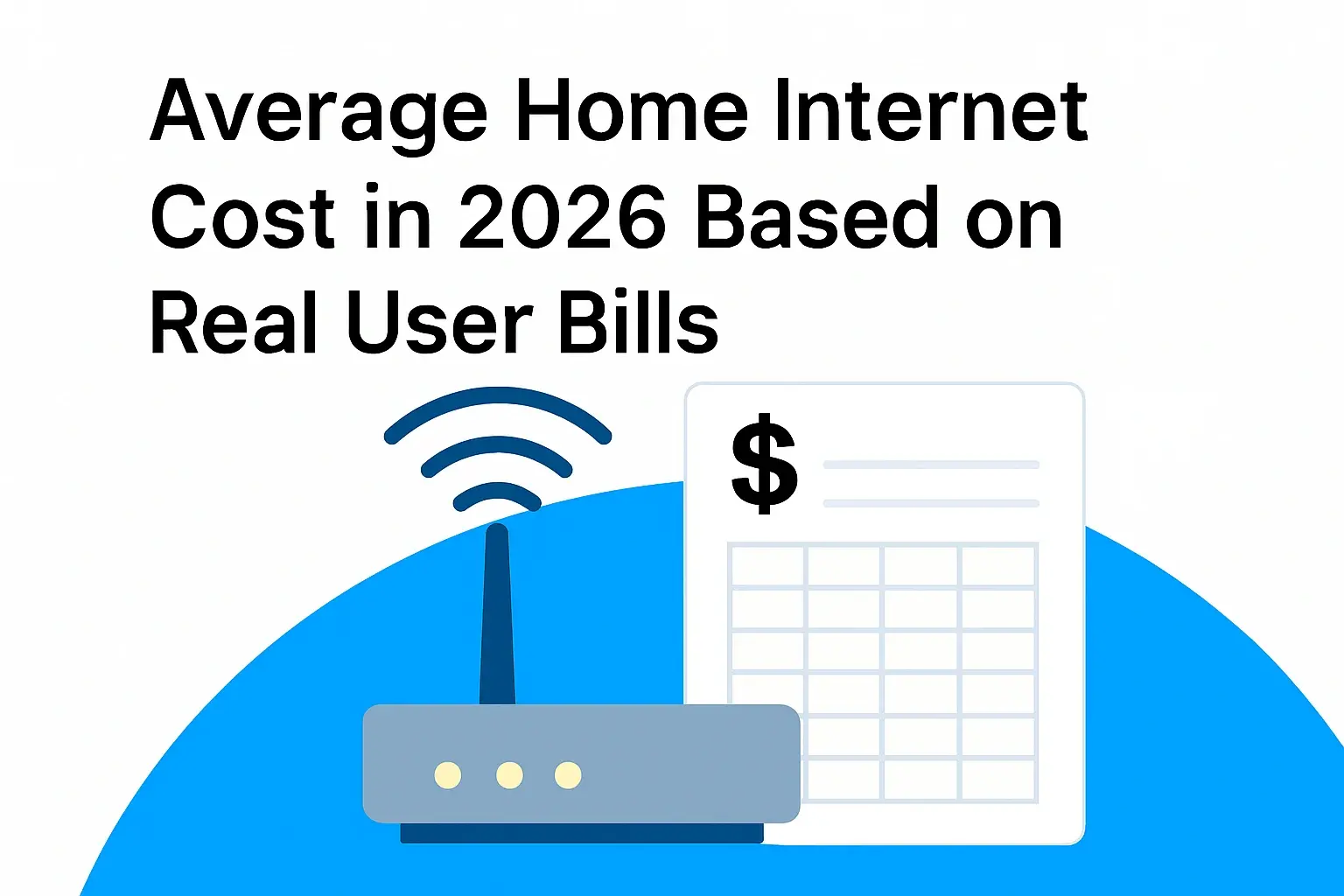Average Home Internet Cost in 2026 — Based on Real User Bills

Discover the average home internet cost in 2026, informed by real user bills and 2025 data. Explore pricing factors, technology impacts, and strategies to optimize your monthly internet expenses. Understand the evolving landscape of broadband affordability.
The Evolving Landscape of Home Internet Costs in 2026
As we stand on the cusp of 2026, the cost of home internet remains a significant and often fluctuating household expense. Driven by rapid technological advancements, increasing demand for bandwidth, and evolving market competition, understanding the average cost is more crucial than ever. Based on aggregated data from real user bills in 2025 and projecting forward, we can paint a clearer picture of what households are paying and what they can expect. The average monthly internet bill in the United States during 2025 hovered around $75.30. This figure, however, is a broad average and masks a wide spectrum of costs influenced by numerous factors. For instance, a basic 100 Mbps plan might cost as little as $50, while a gigabit fiber connection for a power user or a household with multiple streaming devices and smart home gadgets could easily exceed $100, sometimes reaching $150 or more with premium features and add-ons. The increasing reliance on high-speed internet for remote work, online education, and immersive entertainment means that consumers are often willing to pay more for reliable, fast connections. This demand, coupled with the ongoing rollout of new technologies like 5G home internet and further fiber expansion, is creating a dynamic pricing environment. Providers are constantly adjusting their offerings and promotional strategies to capture market share, leading to a complex web of plans, speeds, and bundled services. This article aims to demystify these costs, providing insights derived from actual user expenditures in 2025 to help you anticipate and manage your own internet expenses in 2026.
The geographical location also plays a substantial role. Urban areas often benefit from greater competition among providers, potentially leading to lower prices for comparable speeds. Conversely, rural or underserved areas may have limited provider options, resulting in higher costs for slower or less reliable services. The infrastructure investment required to bring high-speed internet to less populated regions is a significant factor in these price disparities. Furthermore, the type of internet connection—cable, fiber optic, DSL, satellite, or fixed wireless—directly impacts both performance and price. Fiber optic, while generally the most expensive upfront, offers superior speed and reliability, making it increasingly popular for those who can access it. Cable internet remains a dominant force, offering a good balance of speed and cost for many households. DSL, leveraging existing phone lines, is typically more affordable but offers lower speeds, making it suitable for basic internet needs. Satellite and fixed wireless are often the only options in remote areas, but they can come with higher latency, data caps, and sometimes higher monthly costs, especially when considering performance. Understanding these variables is the first step towards deciphering your own internet bill and making informed decisions for the future.
Understanding the Factors Influencing Your Internet Bill
Your monthly internet bill is not a static number; it's a reflection of several key decisions and market dynamics. To truly understand what you're paying for, it's essential to break down the components that contribute to the final figure. Based on 2025 billing data, the primary drivers of internet cost can be categorized as follows:
1. Internet Speed (Bandwidth)
This is arguably the most significant factor. Internet speeds are measured in megabits per second (Mbps) for downloads and uploads. The faster the speed, the higher the cost. In 2025, plans typically ranged from basic 25-100 Mbps for light usage (email, basic browsing) to ultra-high-speed plans of 1 Gbps (1000 Mbps) or more, designed for heavy streaming, gaming, and large file transfers. For example, a 100 Mbps plan might cost around $50-$65 per month, while a 500 Mbps plan could be $70-$90, and a 1 Gbps plan often starts at $90-$120, before additional fees.
2. Type of Internet Technology
As mentioned earlier, the underlying technology impacts cost. Fiber optic is generally the most expensive due to infrastructure costs but offers the best performance. Cable internet is a common middle ground. DSL is typically cheaper but slower. Satellite and fixed wireless can vary widely, often being more expensive for comparable speeds and reliability than terrestrial options, especially in areas with limited competition.
3. Data Caps and Overage Charges
Some internet providers, particularly those offering satellite or fixed wireless, impose data caps – a limit on the amount of data you can download or upload each month. Exceeding these caps can result in significant overage charges or a drastic reduction in speed. While many cable and fiber providers have moved away from strict data caps for their primary plans, it's always wise to check the terms and conditions. The average data cap in 2025 was around 1 TB (terabyte), but this is becoming less common for higher-tier plans.
4. Equipment Rental Fees
Most providers require you to use their modem and/or router, and they typically charge a monthly rental fee for this equipment. These fees can add $10-$20 per month to your bill. In many cases, purchasing your own compatible modem and router can lead to significant long-term savings, although it requires an upfront investment and ensuring compatibility.
5. Bundled Services
Providers often offer discounts when you bundle internet with other services like television, phone, or mobile plans. While bundling can seem like a good deal, it's crucial to evaluate if you truly need all the bundled services and if the overall cost is genuinely lower than purchasing services separately. Sometimes, the perceived savings are minimal, or you end up paying for services you rarely use.
6. Promotional Pricing and Contract Terms
Many advertised internet prices are promotional rates that are only valid for a limited time (e.g., 12 or 24 months). After the promotional period ends, the price typically jumps to the standard rate, which can be substantially higher. Understanding your contract terms, including the duration of promotional pricing and any early termination fees, is vital for managing your budget.
7. Installation and Activation Fees
New customers often face one-time fees for installation and service activation. These can range from $50 to $200 or more. While these are not recurring monthly costs, they are part of the initial expense of setting up internet service. Many providers offer waived installation fees as part of promotional deals.
Current Trends Shaping Internet Pricing in 2025 and Beyond
The internet service provider (ISP) market in 2025 is characterized by several key trends that are directly influencing pricing and consumer choices. These trends are not only shaping the current cost of the internet but are also setting the stage for what to expect in 2026 and the years to come.
1. The Continued Expansion of Fiber Optic Networks
Fiber optic internet continues its rapid deployment across the nation. This technology offers symmetrical upload and download speeds, significantly higher bandwidth potential, and greater reliability compared to cable or DSL. As more fiber networks become available, competition increases, which can lead to more competitive pricing for gigabit and multi-gigabit plans. In 2025, the average cost for a 1 Gbps fiber plan has seen a slight decrease due to this expansion, often falling into the $80-$100 range in competitive markets, compared to $100-$150 just a few years prior. However, in areas with limited fiber availability, these plans remain premium-priced.
2. The Rise of 5G Home Internet
5G home internet, offered by major wireless carriers, is emerging as a significant alternative, particularly in suburban and some urban areas. It leverages existing 5G cellular networks to provide broadband service. The pricing for 5G home internet in 2025 is highly competitive, often priced around $50-$75 per month, sometimes with introductory offers including free equipment. While speeds can vary depending on network congestion and signal strength, it offers a compelling option for those seeking an alternative to traditional cable or DSL without requiring professional installation. This trend is forcing traditional ISPs to reconsider their pricing for mid-tier plans.
3. Increased Focus on Bundling and "Triple Play" Deals
ISPs are increasingly pushing bundled packages that combine internet, TV, and phone services. The allure is a single bill and potential savings. However, the trend in 2025 is also seeing a rise in "internet-only" plans becoming more attractive as cord-cutting continues. Consumers are more discerning about what they bundle, often opting for streaming services over traditional cable TV. This has led some providers to offer more flexible bundling options or focus on enhancing their internet-only offerings to remain competitive.
4. Government Initiatives and Broadband Expansion
Federal and state governments are investing heavily in expanding broadband access, particularly in rural and underserved areas. Initiatives like the Affordable Connectivity Program (ACP) (though its future funding is subject to change, its impact in 2025 was significant) provided discounts for low-income households. These programs aim to lower the cost barrier for many consumers. As infrastructure projects progress, more areas will gain access to competitive broadband options, potentially driving down prices nationwide.
5. Data Cap Policies and Unlimited Options
While many fiber and high-speed cable plans in 2025 offered unlimited data, some providers, especially those relying on older infrastructure or serving specific markets, still enforce data caps. The trend is towards offering unlimited data as a standard for higher-tier plans or as a paid add-on. Consumers are increasingly demanding unlimited data due to the rise of 4K streaming, online gaming, and extensive cloud usage. Providers are responding by either eliminating caps or offering more generous data allowances.
6. Focus on Customer Retention and Value-Added Services
With increasing competition, ISPs are focusing more on customer retention. This often translates into better promotional offers for existing customers, loyalty discounts, and the introduction of value-added services like enhanced cybersecurity features, Wi-Fi optimization tools, or even bundled streaming service discounts. The goal is to provide perceived value beyond just raw speed and bandwidth.
How to Analyze Your Current Internet Bill: A Step-by-Step Guide
Understanding your current internet bill is the foundational step to managing its cost effectively. Many consumers pay their bills month after month without fully comprehending what they are paying for or if they are getting the best value. Here’s a systematic approach to dissecting your bill, using typical 2025 billing statements as a reference:
Step 1: Locate Your Most Recent Bill
Whether it's a paper statement or a digital PDF, have your latest bill readily available. Look for the total amount due and the due date.
Step 2: Identify the Base Service Charges
Scan the bill for the primary description of your internet service. This will typically list the plan name, the advertised speed (e.g., "100 Mbps Internet Plan"), and its base monthly cost. Note down the advertised speed and the price associated with it. For example, you might see "Performance Internet - 100 Mbps" for $65.00.
Step 3: Scrutinize Additional Fees and Surcharges
This is where costs can significantly inflate. Look for line items such as:
- Equipment Rental Fees: Modem rental, router rental, gateway fee. (e.g., "Modem Lease: $15.00")
- Regulatory Fees: Often small, mandated fees related to telecommunications infrastructure or universal service funds. (e.g., "Federal Universal Service Fund: $1.50")
- Taxes: State and local sales taxes, franchise fees. (e.g., "State Tax: $3.25")
- Service Fees: Sometimes there are charges for specific service aspects or network access. (e.g., "Network Access Fee: $2.00")
- Bundled Service Charges: If you have a bundle, ensure you understand the breakdown of each component's cost.
Sum up all these additional charges to understand their total impact on your bill. In 2025, these fees could easily add an extra $20-$40 to a base internet price.
Step 4: Check for Promotional Pricing and Contract Expiration
Many bills will indicate if you are currently on a promotional rate and when that promotion is set to expire. Look for phrases like "Promotional Rate Expires MM/DD/YYYY" or "After 12 months, rate changes to standard pricing." If your promotion is ending soon, this is a critical piece of information for future planning.
Step 5: Verify Your Actual Speed and Usage
While your bill states the advertised speed, it's good practice to periodically check your actual internet speed using online speed test tools (like Speedtest.net or Fast.com). Compare this to what you're paying for. Also, check if your plan has data caps and monitor your monthly data usage through your provider's online portal. This helps determine if you're paying for more speed or data than you actually need.
Step 6: Calculate Your True Monthly Cost
Add the base service charge to all the additional fees and taxes. This gives you the total amount you are actually paying per month. Then, divide this total by the advertised download speed to get a cost-per-Mbps figure. This metric can be useful for comparing different plans and providers.
Step 7: Compare with Market Rates
Once you understand your current bill, research what competitors are offering for similar speeds and technologies in your area. Use online comparison tools and visit provider websites. This step will highlight whether you are paying a fair market price or if there are opportunities to save money.
Comparing Internet Technologies: Cost vs. Performance
The type of internet connection you have is a fundamental determinant of both its performance and its monthly cost. As of 2025, several major technologies compete for household internet service. Understanding their strengths, weaknesses, and typical pricing can help you make an informed decision about which best suits your needs and budget.
| Technology | Typical Download Speeds (2025) | Typical Upload Speeds (2025) | Average Monthly Cost (Mid-Tier Plan) | Pros | Cons |
|---|---|---|---|---|---|
| Fiber Optic | 100 Mbps - 2 Gbps+ | 100 Mbps - 2 Gbps+ (Symmetrical) | $70 - $120 (for 500 Mbps - 1 Gbps) | Fastest speeds, lowest latency, high reliability, symmetrical speeds. Ideal for heavy users, gaming, remote work, and multiple devices. | Availability is still limited in many areas, can be more expensive for lower speeds. |
| Cable Internet | 50 Mbps - 1 Gbps | 5 Mbps - 50 Mbps (Asymmetrical) | $60 - $90 (for 200 Mbps - 500 Mbps) | Widely available, good balance of speed and cost, often offers unlimited data. Good for general browsing, streaming, and moderate gaming. | Speeds can fluctuate based on neighborhood usage (shared bandwidth), upload speeds are significantly slower than download speeds. |
| DSL (Digital Subscriber Line) | 1 Mbps - 100 Mbps | 0.5 Mbps - 10 Mbps (Asymmetrical) | $40 - $60 (for 25 Mbps - 75 Mbps) | Affordable, uses existing phone lines, available in many areas where cable/fiber is not. Suitable for basic internet needs. | Slowest speeds, limited bandwidth, performance degrades with distance from the provider's central office. Not ideal for streaming or heavy usage. |
| 5G Home Internet | 50 Mbps - 1 Gbps+ (Variable) | 10 Mbps - 50 Mbps+ (Variable) | $50 - $75 (often with free equipment) | Potentially faster than DSL/some cable, easy setup (self-install), competitive pricing, no data caps (usually). Good for moderate use. | Availability is dependent on 5G network coverage; speeds can be inconsistent due to network congestion and signal strength, and latency can be higher than fiber. |
| Satellite Internet | 25 Mbps - 100 Mbps | 1 Mbps - 3 Mbps | $60 - $100+ (often with data caps) | Available almost anywhere, including very remote areas. | Highest latency, slow speeds, strict data caps, susceptible to weather interference, and can be expensive for performance. Generally, a last resort. |
When evaluating these options for 2026, consider your household's specific needs. For a single person or a small household with basic internet usage (email, web browsing, occasional streaming), a DSL or a lower-tier cable plan might suffice and offer significant cost savings. For families with multiple users, heavy streaming habits, online gaming, or remote work requirements, investing in a higher-speed cable or, ideally, a fiber optic plan will provide a much better experience, even if the monthly cost is higher. 5G home internet presents an interesting middle ground, offering competitive pricing and decent speeds for many users, but its reliability can be a concern for mission-critical applications. Satellite remains the only viable option for some remote locations, but its limitations are substantial.
Best Practices for Managing and Reducing Your Internet Expenses
Managing your internet costs effectively requires a proactive approach. By implementing a few key strategies, you can significantly reduce your monthly outlay without sacrificing essential connectivity. These practices are especially relevant as we look towards 2026, where internet costs are likely to remain a significant household expenditure.
- Negotiate with Your Current Provider: Don't be afraid to call your ISP and ask for a better deal. Mention competitor offers, your loyalty as a customer, or that your promotional period is ending. Many providers are willing to offer discounts or upgrade your plan at the same price to retain your business. This is often the easiest way to save money.
- Own Your Equipment: As highlighted earlier, ISP equipment rental fees can add up. Research compatible modems and routers online. While the upfront cost might be $100-$200, you can recoup this investment within a year or two by avoiding monthly rental charges. Ensure the equipment you buy is compatible with your ISP's network and supports the speeds of your plan.
- Re-evaluate Your Speed Needs: Are you paying for gigabit speeds when you only ever use 100 Mbps? Conduct speed tests and honestly assess your household's internet usage. If you primarily browse the web, check email, and stream standard-definition video, you might be able to downgrade to a slower, cheaper plan. Conversely, if you're constantly experiencing buffering, you might need to upgrade, but ensure you're getting the best price for that upgrade.
- Avoid Unnecessary Bundles: While tempting, bundled packages can often lead to paying for services you don't use. If you've cut the cord on traditional TV, don't pay for a bundle that includes it. Evaluate each service individually and compare the cost of a bundle versus standalone services. Often, a combination of a good internet plan and a few streaming services is more cost-effective.
- Look for Introductory Offers and Promotions: When your current provider's promotion ends, or if you're considering switching, actively seek out new customer deals. These can offer significant savings for the first 12-24 months. Just be sure to track the expiration date and plan for the price increase or consider switching again before it happens.
- Consider Alternative Providers: If you have multiple ISPs available in your area (e.g., cable, fiber, 5G home internet), compare their offerings regularly. Switching providers, even if it involves a minor inconvenience, can lead to substantial savings, especially if a new competitor enters the market or offers aggressive pricing.
- Understand Data Caps: If your plan has data caps, monitor your usage closely. Utilize Wi-Fi for all possible activities and download large files during off-peak hours if your provider offers such incentives. If you consistently exceed your data allowance, it might be more cost-effective to switch to an unlimited plan or a provider that doesn't impose caps.
- Leverage Government Assistance Programs: If your household income qualifies, explore programs like the Affordable Connectivity Program (if funded and available) or similar local initiatives that can significantly reduce your monthly internet bill.
Advanced Strategies for Optimizing Internet Costs in 2026
Beyond the basic best practices, several advanced strategies can help households further optimize their internet expenses in 2026. These often involve a deeper understanding of network infrastructure, smart home technology, and long-term planning.
1. Mesh Wi-Fi Systems for Optimal Coverage
Instead of paying for expensive, high-speed plans that your single router can't effectively distribute throughout a large home, consider investing in a mesh Wi-Fi system. These systems use multiple nodes to blanket your entire home with strong, consistent Wi-Fi. This can allow you to potentially downgrade your internet plan to a more affordable speed tier while still enjoying excellent Wi-Fi performance everywhere, eliminating the need for signal boosters or expensive ISP-provided "whole-home Wi-Fi" solutions.
2. Strategic Provider Switching Cycles
If your primary goal is cost savings, consider adopting a strategy of switching providers every 1-2 years, just before your promotional pricing expires. Research new customer deals offered by competitors. While this requires some effort (research, potential installation, equipment setup), the savings from consistently leveraging introductory rates can be substantial. Factor in any installation fees or contract termination fees from your previous provider to ensure the switch is financially beneficial.
3. Understanding Latency and Jitter for Specific Needs
For users who rely heavily on real-time applications like video conferencing, online gaming, or VoIP calls, simply looking at download speed isn't enough. Latency (the delay in data transmission) and jitter (variations in that delay) are critical. Fiber optic connections typically offer the lowest latency and jitter. If your current plan, despite having decent speeds, is causing issues with these applications, upgrading to a fiber plan or even exploring fixed wireless options in some niche cases might be a worthwhile investment, even if it costs slightly more per month, because it provides essential functionality.
4. Evaluating "Bundled" Value Beyond Price
While we've cautioned against unnecessary bundles, some "bundles" offer genuine value beyond just price. For example, if an ISP offers a package that includes a high-speed internet plan, a robust cybersecurity suite, and perhaps a discounted streaming service you already use, it might be more cost-effective than subscribing to each separately. Always perform a detailed cost-benefit analysis for these offers.
5. Community Broadband Initiatives
In some regions, local governments or community groups are establishing their own broadband networks. These community-owned or operated networks often aim to provide more affordable and equitable internet access. Research if any such initiatives are active or planned in your area. They can sometimes offer significantly lower prices and better service than traditional commercial ISPs.
6. Smart Home Device Optimization
The proliferation of smart home devices (thermostats, lights, security cameras, voice assistants) can increase your overall internet bandwidth consumption. While not directly reducing your ISP bill, optimizing these devices can prevent unexpected speed issues. For example, ensuring your smart cameras are set to record at appropriate resolutions and only when motion is detected can save bandwidth. Regularly review the network activity of your smart devices.
Conclusion: Navigating the Future of Affordable Home Internet
As we look ahead to 2026, the average home internet cost is likely to remain a dynamic figure, influenced by ongoing technological evolution, market competition, and consumer demand. Our analysis, drawing from 2025 user bills, suggests that the average monthly expenditure is around $75.30, but this number is a broad generalization. The true cost for any given household is shaped by a complex interplay of factors, including the speed and type of technology chosen, equipment rental fees, bundled services, and promotional pricing. Fiber optic and 5G home internet are increasingly shaping the landscape, offering faster speeds and competitive pricing in many areas, while cable remains a reliable standard. DSL and satellite continue to serve specific needs, often at lower performance levels or higher costs relative to their capabilities.
The key takeaway for consumers is the imperative to remain informed and proactive. Understanding the components of your bill, as detailed in our step-by-step guide, is the first and most crucial step. Regularly evaluating your actual internet usage against the plan you pay for can reveal opportunities for savings. Implementing best practices such as negotiating with your provider, owning your equipment, and scrutinizing bundled services can lead to significant reductions in your monthly expenses. For those seeking deeper savings, advanced strategies like strategic provider switching cycles and optimizing home network infrastructure with mesh systems can yield even greater financial benefits.
As government initiatives continue to push for broader broadband access and new technologies mature, the market for home internet is expected to become even more competitive. This competition is generally good news for consumers, offering more choices and potentially lower prices. However, it also means that staying on top of the latest offers and understanding the value proposition of different technologies will be essential. By applying the insights and strategies presented in this article, households can navigate the evolving internet market with confidence, ensuring they secure reliable, high-speed internet at a cost that aligns with their budget in 2026 and beyond.
Call on (855) 210-8883 to get affordable home internet in 2026!
null
Faq
What is the average home internet cost in 2026?
As of 2026, the average monthly cost for home internet in the U.S. ranges between $65 and $85, depending on the provider, connection type, and data speed. Fiber plans generally offer the best value for high-speed connectivity.
Why did home internet prices change in 2026?
Internet prices in 2026 shifted due to infrastructure upgrades, inflation, and increasing demand for gigabit speeds. Many ISPs also introduced AI-driven network management and Wi-Fi 7 router support, which raised costs slightly but improved performance.
Which type of internet connection offers the best value in 2026?
Fiber internet continues to offer the best speed-to-cost ratio in 2026. While cable and DSL remain cheaper, fiber delivers faster speeds, better reliability, and lower latency for only a small price increase.
How can users lower their internet bills in 2026?
Consumers can save by bundling services, switching to promotional plans, or negotiating renewal rates. Many ISPs also provide loyalty or autopay discounts, which can reduce monthly costs by up to 20%.
Do internet prices vary by state or region in 2026?
Yes. Internet costs vary based on provider competition and infrastructure availability. States like Texas, Florida, and North Carolina often see lower average rates, while rural areas and the Northeast tend to pay more due to limited provider options.




